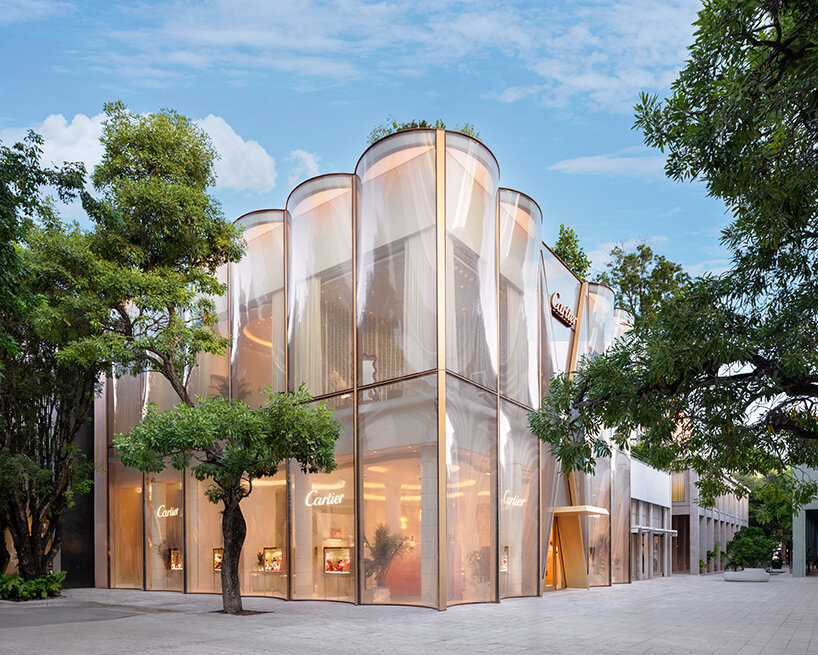Casa SEL / CampoTaller
2017-04-28 17:58
Completed by Mexican studio CampoTaller, Casa SEL is situated in the Coyoacán neighborhood of Mexico City. The project consists of the modification and intervention of a house built in the 1970s.
由墨西哥工作室CampoTaller完成,CasaSEL位于墨西哥城的Coyoacán社区。该项目包括对1970年代建造的一座房屋进行改造和干预。
Modification: One of the primary targets was admitting daylight into all interior spaces and improving the visual connection between the house and its immediate surroundings. The garden is dominated by a more than 80 years old peppercorn tree that is framed on two sides by the building.
修改:主要的目标之一是允许日光进入所有室内空间,并改善房屋与其周围环境之间的视觉联系。花园里有一棵80多年历史的胡椒树,它的两侧都是在这座建筑旁边。
The original building structure had windows with false arches and thick wooden frames. Both have been changed and the new, rectangular steel frames offer a better view and general transparency on the ground floor level. The necessity of constructing a new cistern in the garden was taken as a pretext to create a surface of water on top of the container, serving as a mirror for the crown of the adjoining peppercorn tree and to cool down the air flowing through the garden.
原来的建筑结构有假拱门和厚木框架的窗户。这两者都已改变,新的矩形钢框架提供了一个更好的看法和一般透明度的底层水平。在花园里建造一个新的水池的必要性被当作在容器顶部创造水面的借口,充当毗邻的胡椒树冠的一面镜子,并使流经花园的空气变凉。
The interior was reorganized, demolishing walls in order to organize kitchen, dining space and living room in a “plan libre”. The newly introduced wooden staircase becomes part of the integrated furniture on ground floor and first floor.
内部进行了重组,拆除了墙壁,以便将厨房、餐厅和起居室组织成一个“平面建筑”。新引进的木楼梯成为一楼和一楼综合家具的一部分。
Intervention: The intervention consists of the reactivation of the roof terrace as a loggia/greenhouse, that also serves as the a vestibule to the first floor bedroom which is extended by an extra bathroom. A service room on the ground floor is reduced to a minimum, generating a service patio on the back of the house. This new exterior space offers light and ventilation for the kitchen. The now detached service room is provided with a new, permeable facade made out of extremely light clay tiles, stacked with minimum use of cement and a technique similar to a house of cards.
干预:干预包括重新激活屋顶地坪作为木地板/温室,也用作一层卧室的前厅,通过额外的浴室延伸。一层的服务室被减少到最低,在房子的后面产生一个服务天井。这一新的外部空间为厨房提供轻盈透气。现在分离的服务室配备了一个新的透水立面,该立面由极轻的粘土砖制成,堆放时最少使用水泥和类似于卡片的技术。
In order to make a visual distinction between the original structure and the new parts of the building, an experimental shuttering technique was used for the concrete elements cast in place: the surface structure is created by introducing petate-sheets (carpet-like elements that are hand woven out of palm-leaves) into the concrete mold. The almost organic looking concrete gives an additional reference to the clients, two biologists and plant lovers.
为了从视觉上区分建筑物的原始结构和新的部分,对浇铸的混凝土元件采用了一种实验模板技术:通过在混凝土模型中引入花瓣片(从棕榈叶手工编织的类似地毯的元素)来创建表面结构。几乎是有机的混凝土提供了一个额外的参考客户,两个生物学家和植物爱好者。
Architects: CampoTaller Project: Casa SEL Architect in Charge: Arch. Humberto Moreno H. Structures: Arch. Ricardo Camacho Assistants: Arch. Carlos Jair Odriozola V. Location: Coyoacán, Mexico City, Mexico Photography: Moritz Bernoulli
建筑师:CampoTaller项目:CASA SEL建筑师主管:ARCH。Humberto Moreno H.结构:拱形。里卡多·卡马乔助理:阿奇。Carlos Jair Odriozola V.地点:Coyoacán,墨西哥城,墨西哥摄影:Moritz Bernoulli
 举报
举报
别默默的看了,快登录帮我评论一下吧!:)
注册
登录
更多评论
相关文章
-

描边风设计中,最容易犯的8种问题分析
2018年走过了四分之一,LOGO设计趋势也清晰了LOGO设计
-

描边风设计中,最容易犯的8种问题分析
2018年走过了四分之一,LOGO设计趋势也清晰了LOGO设计
-

描边风设计中,最容易犯的8种问题分析
2018年走过了四分之一,LOGO设计趋势也清晰了LOGO设计











































































